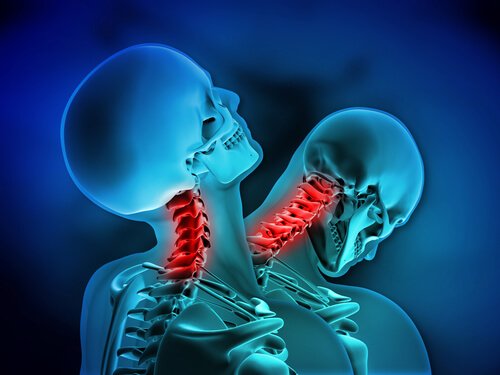Whiplash Symptoms, Causes, and Treatment


Reviewed and approved by the psychologist Gema Sánchez Cuevas
Thousands of people are involved in car accidents every year. In fact, automobile-related incidents are still one of the leading causes of death in many countries. Nevertheless, even when a car accident doesn’t result in death, their consequences could still be very serious. One of the most common and bothersome consequences of car accidents is whiplash. Today, we’ll discuss whiplash symptoms and treatment.
Whiplash is neck pain that manifests when this delicate part of the body is subjected to sudden acceleration and deceleration. As such, it tends to manifest after car accidents in which someone has had to break suddenly. Another situation where whiplash commonly manifests is when you’re rear-ended on the road. Whiplash symptoms are varied and can be annoying and also dangerous.
In this article, we’ll tell you everything you need to know about whiplash symptoms, causes, and treatment.

Why do people get whiplash?
When you break very suddenly or someone rear-ends you, the car’s acceleration is transmitted directly to your neck. This causes the weight of your head (usually about 16 lbs.) to momentarily spike to about 100 lbs. This is a lot more weight than the cervical vertebrae can support.
Due to this weight, some neck ligaments or muscles tear. One of the main whiplash symptoms is intense pain in this area, which could spread to the head or back.
Some studies show that the symptoms of whiplash aren’t related to any sprain. Some experts suggest that it’s actually a psychosomatic problem. In other words, it could just be a product of stress rather than physical harm.
In general, this isn’t a very dangerous condition. It even tends to go away on its own after a few days. However, sometimes the symptoms do persist for a long time or are particularly severe. In that case, experts recommend you go see a doctor to rule out any bigger issues.
Most common whiplash symptoms
- Neck pain: Tends to manifest immediately or in the hours following the accident.
- Neck stiffness: This manifests as difficulty moving your neck.
- Head pain: Usually in the upper part of the head.
- Dizziness or vertigo: The feeling that you’ll suddenly lose your balance at any moment.

Some people have less-common symptoms. For example, some people with whiplash complain of pain that extends to their arms or back. Additionally, they may suffer from tinnitus (a bothersome ringing in the ears).
Some people even manifest emotional symptoms, such as anxiety and post-traumatic stress, due to the accident.
How is it treated?
Whiplash responds well to treatment. Until recently, experts recommended that those who suffer from it avoid moving their neck too much because they argued that this sped up recovery. This is because they believed an internal neck sprain was the cause of whiplash.
Despite these old assumptions, recent studies show that the use of a cervical collar to immobilize the neck can lead to longer recovery times. This actually weakens the muscles in the area because there’s still an uneven strain on them, as some will always be tense and others will always be relaxed.
As such, today experts recommend that people with whiplash try to lead a normal life after their accident. They recommend the use of surgical collars for specific purposes, such as driving.
On the contrary, some experts say that physical exercises for strengthening the neck muscles could reduce recovery time. In cases where there’s a lot of pain, you could also benefit from painkillers and anti-inflammatory drugs.
As you can see, whiplash can be quite annoying. Nevertheless, whiplash symptoms usually don’t signal serious consequences. If you seem to have lasting emotional problems after a car incident, you should seek the help of a psychotherapist.
Thousands of people are involved in car accidents every year. In fact, automobile-related incidents are still one of the leading causes of death in many countries. Nevertheless, even when a car accident doesn’t result in death, their consequences could still be very serious. One of the most common and bothersome consequences of car accidents is whiplash. Today, we’ll discuss whiplash symptoms and treatment.
Whiplash is neck pain that manifests when this delicate part of the body is subjected to sudden acceleration and deceleration. As such, it tends to manifest after car accidents in which someone has had to break suddenly. Another situation where whiplash commonly manifests is when you’re rear-ended on the road. Whiplash symptoms are varied and can be annoying and also dangerous.
In this article, we’ll tell you everything you need to know about whiplash symptoms, causes, and treatment.

Why do people get whiplash?
When you break very suddenly or someone rear-ends you, the car’s acceleration is transmitted directly to your neck. This causes the weight of your head (usually about 16 lbs.) to momentarily spike to about 100 lbs. This is a lot more weight than the cervical vertebrae can support.
Due to this weight, some neck ligaments or muscles tear. One of the main whiplash symptoms is intense pain in this area, which could spread to the head or back.
Some studies show that the symptoms of whiplash aren’t related to any sprain. Some experts suggest that it’s actually a psychosomatic problem. In other words, it could just be a product of stress rather than physical harm.
In general, this isn’t a very dangerous condition. It even tends to go away on its own after a few days. However, sometimes the symptoms do persist for a long time or are particularly severe. In that case, experts recommend you go see a doctor to rule out any bigger issues.
Most common whiplash symptoms
- Neck pain: Tends to manifest immediately or in the hours following the accident.
- Neck stiffness: This manifests as difficulty moving your neck.
- Head pain: Usually in the upper part of the head.
- Dizziness or vertigo: The feeling that you’ll suddenly lose your balance at any moment.

Some people have less-common symptoms. For example, some people with whiplash complain of pain that extends to their arms or back. Additionally, they may suffer from tinnitus (a bothersome ringing in the ears).
Some people even manifest emotional symptoms, such as anxiety and post-traumatic stress, due to the accident.
How is it treated?
Whiplash responds well to treatment. Until recently, experts recommended that those who suffer from it avoid moving their neck too much because they argued that this sped up recovery. This is because they believed an internal neck sprain was the cause of whiplash.
Despite these old assumptions, recent studies show that the use of a cervical collar to immobilize the neck can lead to longer recovery times. This actually weakens the muscles in the area because there’s still an uneven strain on them, as some will always be tense and others will always be relaxed.
As such, today experts recommend that people with whiplash try to lead a normal life after their accident. They recommend the use of surgical collars for specific purposes, such as driving.
On the contrary, some experts say that physical exercises for strengthening the neck muscles could reduce recovery time. In cases where there’s a lot of pain, you could also benefit from painkillers and anti-inflammatory drugs.
As you can see, whiplash can be quite annoying. Nevertheless, whiplash symptoms usually don’t signal serious consequences. If you seem to have lasting emotional problems after a car incident, you should seek the help of a psychotherapist.
All cited sources were thoroughly reviewed by our team to ensure their quality, reliability, currency, and validity. The bibliography of this article was considered reliable and of academic or scientific accuracy.
Keidel, M. (2003). Whiplash Injury. In Neurological Disorders: Course and Treatment: Second Edition. https://doi.org/10.1016/B978-012125831-3/50205-7
Treleaven, J., Jull, G., & Sterling, M. (2003). Dizziness and unsteadiness following whiplash injury: Characteristic features and relationship with cervical joint position error. Journal of Rehabilitation Medicine. https://doi.org/10.1080/16501970306109
Sterling, M. (2009). Physical and psychological aspects of whiplash: Important considerations for primary care assessment, Part 2 – Case studies. Manual Therapy. https://doi.org/10.1016/j.math.2008.03.004
Jull, G. A., Söderlund, A., Stemper, B. D., Kenardy, J., Gross, A. R., Côté, P., … Curatolo, M. (2011). Toward optimal early management after whiplash injury to lessen the rate of transition to chronicity. Spine. https://doi.org/10.1097/BRS.0b013e3182388449
This text is provided for informational purposes only and does not replace consultation with a professional. If in doubt, consult your specialist.







